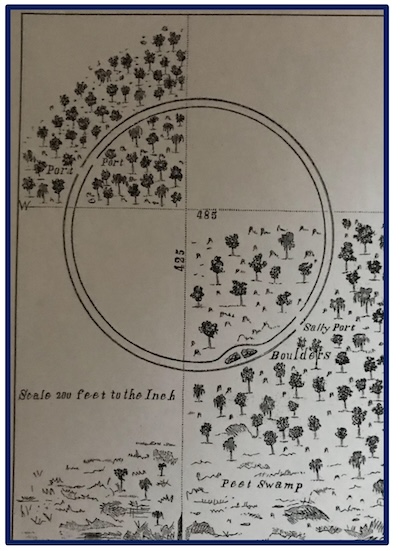Evidence shows early residents from about 400 years ago
Large bone pit among artifacts of Neutral Indians in Shelby
By Catherine Cooper, Orleans County Historian
“Illuminating Orleans” – Volume 4, Number 38

Diagram of the Shelby site drawn by Frank Cushing in 1879. (From: Illustrated Historical Album of Orleans County, 1879) The site, which is indicated by a historic marker, is located on Salt Works Road, half a mile south of Blair Road, on the left when traveling south.
SHELBY – “In the town of Shelby, Orleans County, New York, about three miles south of the village of Medina are the remains of one of the most interesting ancient earthworks in the state.”
Thus begins a description of the archaeological site at Shelby presented to the Smithsonian Institute in 1874. It was written by Frank H. Cushing, then aged 17, who had just joined the staff of the Smithsonian. He went on to have a distinguished career as an ethnologist of the Zuni Indians in New Mexico.
As a young boy, Cushing was captivated by the then abundant evidence of American Indian life in this area and particularly at the Shelby site. He camped out there on his own for days at a time and wrote the definitive description of the site. The features of the site have been obliterated over time.
Here are excerpts from Cushing’s description which was included in the Historical Album of Orleans County published in 1879:
“It consists of two mural embankments, which are now about two feet in height, parallel, and two feet distant from each other. They describe almost an exact circle, having a diameter of four hundred and thirty feet and an area of three and one third acres.
“Two fences upon original section lines, running one north and south, the other east and west, divide this enclosure into four nearly equal parts or quadrants.
“Traces of a moat, which once encircled this work, are still discernable at intervals. The moat is broad in proportion to its present depth…it was probably made by the removal of the earth for the construction of the walls.
“Ten rods south of this work lies a peat swamp….this was probably a shallow lake at the time when the works were constructed. The supply of fish in this lake was abundant.
West from the work, at a distance of half a mile, on the eastern slope of a sand hill, is a large bone pit, where the bones of many hundreds have been deposited.

Diagram of the fort prepared by Frank R. Berger. In September 1990, at the urging of Mr. Berger, the historic marker which had originally placed “three fields in” in 1932, was relocated to a more visible location on Salt Works Road.
“On making excavations in those portions still uncultivated, many specimens of great interest are found. They usually lie from 6 to 18 inches beneath the surface, often embedded in charcoal and ashes. They consist of hammers, sinkers, stone ornaments, pipes, pottery; also implements and ornaments of bone, such as bone splinters, awls and needles, daggers or dirks, cylindrical ear ornaments, implements for the ornamentation of pottery, perforated metatarsals and perforated teeth.”
Referred to as the Neutral or Neuter Indians because they did not take sides in the wars against the Hurons, the inhabitants of the Shelby site were part of the Iroquois confederacy. Recent scholarship suggests that they may more specifically be identified as Wenro people.
They were hunters and engaged in a fur trade with the Huron Indians. It appears that they fell victim to the enmity of the Iroquois against the Hurons, during a bellicose era in the mid-1600s referred to as the Beaver Wars. The Hurons were the main rivals of the Iroquois in the fur trade. The Iroquois destroyed both the Hurons and the Neutrals.
It is intriguing to consider the lives of the people who lived in this palisade some 300 years ago, before the area was surveyed and sold, and before the political jurisdictions that we are familiar with, were determined.






























































